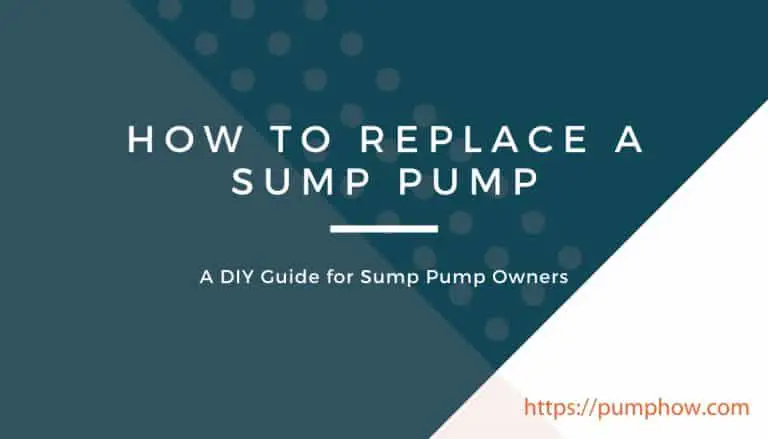For a sump pump to function properly, a drain system needs to be in place that directs the pumped water effectively away from your house and all other surrounding structures to a suitable outlet like a ditch or a drainfield.
Many homeowners keep drain lines on top of their lawns. The problem with this particular practice is that they have to move the lines regularly while mowing the lawns, and this removal presents a trip-and-fall issue in those yards.
If you can’t install the drain system properly, chances are, potholes may show up on your paved roads or water clogging may submerge an unpaved lane. Even the sidewalk or local streets may go under water. So, we’ll discuss the right way on how to install sump pump drain system, so it doesn’t cause more problems than it solves.
You need not keep yourself free of your daily schedules for a full day because the project won’t take you longer than an hour. The cost can be $50 to $100 or even more depending on how many of the required items are already at your disposal.

Prepare Yourself: Gears You Need To Install The Sump Pump Drain System
Arm yourself with safety items like gloves, glasses, and ear protection. You won’t need them just as you start, but don’t forget to wear them while applying PVC cement and using power tools like a drill, a hacksaw, etc.
Gather Your Things: List Of Items for The Sump Pump Drain System
Collect the following items and tools before starting the project.
- PVC Piping (Size: 1.25″ or 1.5″)
- PVC Pipe Fittings
- PVC Increaser
- 3″ to 4″ PVC Pipe
- Check Valve
- PVC Cement
- Silicone caulk
- Screwdriver
- Hacksaw
- Drill with 1/4″ and 2″ bits
Optional Tools
- Male PVC pipe adapter
- Rotary hammer
- Excavating tools like mattocks, shovel, etc.
8 Steps to Install a Drain System for Your Sump Pump
There’re several ways to run a discharge system for a sump pump, you can bring changes to the following instructions considering the very sump system and basement situation of your home. We’ve presented a standard procedure for you to follow.
1. Attaching a PVC Pipe
Find the discharge port on the sump pump and attach a PVC pipe to it. For this attachment, you want to glue the male adapter to a particular spot of the discharge pipe prior to placing that adapter into the pump’s female adapter. It’s the typical process.
2. Creating a Weep Hole
You need to create a weep hole on the PVC pipe. Drill a 1/4″ hole in that pipe in a way that the hole stays at least six inches above the discharge system on the pump.
3. Installing a Check Valve
At this point, you’ll install a check valve that prevents the pumped water from going back into your sump. Use the hacksaw and cut into your pipe to install a check valve in the pump’s discharge line located above the newly created weep hole. A vertical check valve with hose clamps and rubber couplings is the most appropriate choice. Tighten those couplings over that pipe using a screwdriver.
4. Drilling a Hole on the Wall Where the Drain Exits
The drain exits the basement structure at a certain point. Locate that point and create a hole on it so that the hole penetrates right through the material of the wall. Now, locate a wooden rim joist and bore an opening right through it.
You need a hole drilled from the inside so that you can find the position clearly from the outside before drilling from there with a 2″ drill bit. The hole has to be 1/4″.
You shouldn’t drill from the inside because the hole may cause splintering or damages to the siding. Use a rotary hammer to drill through a brick wall.
5. Directing the Discharge Line
Attach the PVC fittings and pipe securely using PVC cement. You’ll have several additional sections. Direct and extend your discharge line with those sections until it touches the hole (you created) to the exterior and enters a few inches through the bored opening.
Use silicone caulk to seal that opening around your discharge pipe. The seal should be too solid to let air or water enter around the pipe.
6. Excavating a Trench
Since you want to direct the drain system underground to an outlet or drainfield, you have to excavate a trench that includes a bottom that is slightly sloped. This particular style of the bottom is necessary for the water flow to be smooth.
If you choose to have a perforated PVC pipe so that drainage may occur across a broader area, you must ensure that the trench base is built with coarse, compacted gravel. Prepare several inches of gravel.
7. Increasing the PVC’s Reach
Use glue to the end of your discharge pipe and attach a PVC increaser to it. The purpose is to increase the original pipe’s width to 3″-4″ across. By widening the discharge pipe, you can allow it to spread out the water flow effectively while minimizing the likelihood of channeling issues that might occur to the outlet.
8. Doing Other Attachments and Finishing the Job
Examine if the drain line has reached your chosen outlet. If it’s yet to reach, you can attach additional pipe sections and fittings from a larger PVC pipe. Once it’s okay; you must refill the excavated space properly.
A PVC pipe might be required to cover a long distance between the sump pump to its opening and to its exterior. If it applies to your situation, you can bring a few clamps or J-hooks and secure the pipe to the wall or beams.
How to Keep Your Drain System from Freezing?
How you make a drain system is what determines how it will work and handle clogging and freezing, which seem to be the most annoying problems in a typical sump pump drain system, especially during colder seasons.
You may want to include this as a part of sump system maintenance, but you can prevent the problems by following these few tips.
- The point where the water exits from needs to be set at a distance of 10-20 feet from the house.
- Get a pipe designed to be freeze-resistant. Attach that pipe to the end point of your drain line.
- You should put the drain line as low underground as possible. If you can’t bury too deep, identify the line where frosting occurs in the ground. Keep the drain line below that.
- If you’re about to do this during one of the winter months when frozen ground is just commonplace, you can’t bury the line deep under the ground. Use a special outlet that blends in with your lawn and keeps the line free of clogging due to debris. However, put it under the ground as soon as the frozen ground thaws or becomes soft.
- Proper insulation might work well. Use tape and straw to insulate the drain line’s exterior.
- A good way to add to the line is adding a pipe with a larger diameter than that of the original line. Surround your existing drain line using the one with a larger diameter.
- Locate the exit pipe of the line and apply a protector.
- Use an ice guard system if “freezing” seems to be a big deal.
Despite everything explained above, your efforts may not meet the expected end because you haven’t taken care of a few more things, a few mistakes actually.
3 Common Mistakes to Avoid While Installing a Drain Line
In some cases, these mistakes may not seem as grave as they practically are, but the result can be too bitter for you to accept. So, try to avoid them.
1. Sizing the Drain Line Inappropriately
Each sump pump comes with a certain (pumping) capacity rating, known as gallons per minute (GPH). One of the factors to help determine the ratings is the “head height” that expresses the vertical distance your pump can push the liquid until it touches the exit point from the basement.
The head height can be 10 feet where the height of a typical basement is eight feet. A smaller head height results in the discharge of more water each minute. A larger head height only results in a decreased capacity. But where’s the drain system’s part in it?
Well, the size of your sump’s discharge line has something to do with its capacity rating. The pre-built fitting on most sumps is appropriate for a discharge pipe with a certain interior diameter which is typically 1.25″/1.5″. Since PVC is the most popular choice of material for sump pump discharge systems, you can’t ignore the exterior diameter which can be up to 1.5″ on one end and 2″ on another.
If you choose a slightly large discharge pipe by mistake, it won’t cost you much. But don’t risk using a pipe with too small a diameter because it will only affect the efficiency and capacity of your pump negatively. It’s nearly impossible for the pump to discharge the rated amount of water through a pipe that’s too small. There’ll be an increased amount of friction which may create back-pressure, making it more challenging for the pump to move the water.
Every discharge cycle is going to be unusually lengthier owing to a reduced amount of liquid. The sump basin gets more time to get filled with the pump kicking on to empty it. This keeps the pump running for longer than the duration it can handle. You know what to expect from a continuously running sump!
2. Running the Drain Line into the Sewer
Connecting the drain system of your pump to your property’s sanitary sewer is not only illegal but also an unfriendly practice. Let’s know why it’s a serious mistake.
Your sump system pumps rainwater and groundwater while the sanitary sewer carries sewage instead of rainwater or groundwater. The diameter of a typical sewer pipe is 8 inches, and its slope isn’t much steep, exacting only 0.4% of the pipe’s diameter. So, a sewer pipe that measures 100 feet goes downward about 5 inches.
It’s the common condition of the slopes of sewer pipes in America which allow only 300 gallons of liquid (water) to flow through them per minute. In event of the amount of sewage being higher than this, it’s likely for the sewage to surcharge and eventually start filling up its lateral pipes which run toward the sewer main-right from residences.
As the sewer pipe starts receiving this much water or sewage, it becomes prone to surcharge quicker. At some point, it must push back into the basement of someone’s house. On occasions, that excess sewage might their way into a neighbor’s washing machine drain or underneath their basement toilet and eventually come out of those places. Imagine what happens afterwards!
You must consider this very potential before this becomes a nuisance and makes you look like a foolish or inconsiderate neighbor. This also gives you all the more reasons to run a sump’s drain to the yard. You can choose a storm sewer which is certainly a better place than the sanitary sewer.
3. Not Securing the Hose to the PVC Pipe
Maybe, you did what was needed, but the discharge hose might get loosened from a firm connection to the PVC pipe and start leaking. Putting down some tarp may seem like a lifesaver but not as good as securing the hose to the pipe.
Final Words
That’s the entirety of our discussion. Now what?
Even with the most efficient drain system, you may have to regret having low spots but no slopes. One or more low spots near your home’s foundation shouldn’t be a surprise, but the situation that the water can’t go anywhere but into your basement makes a shocking case.
Create 6 inches of slope over 10′ away from the house. It’s a small correction but makes a huge difference in your basement waterproofing project. After all, the sump system and all the other components it relies on work together to keep your basement safe. So, a little extra attention to them always pays off. Feel free to ask anything that helps you with this concern.






